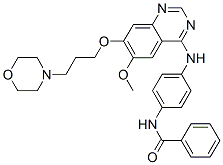All AbMole products are for research use only, cannot be used for human consumption.

ZM447439 is an Aurora kinase B inhibitor, suppresses the growth of cervical cancer SiHa cells and enhances the chemosensitivity to cisplatin. Aurora family kinases play roles in several mitotic processes, including the G2/M transition, mitotic spindle organization, chromosome segregation, and cytokinesis. ZM447439 has dramatic effects on chromosome morphology and spindle dynamics. ZM-447439 can reduce the number of SiHa cells, increase the volume of cells and lead to apoptosis. The growth of SiHa cells treated with ZM447439 was inhibited in dose- and time-dependent manners. ZM447439 significantly inhibited the expression of Aurora-B and H3-P protein (P < 0.05). ZM-447439 selectively over a range of other kinases such as Cdk1 and PLK1 (up to 10mM). Additionally, aurora kinase inhibition by ZM447439 potently induced apoptosis, which was accompanied by DNA fragmentation and caspase 3 and 7 activation.
| Cell Experiment | |
|---|---|
| Cell lines | MCF7 cells |
| Preparation method | Cell cycle analysis and cloning assays. DNA content and mitotic index measurements and synchronization of TA-HeLa cells at G1/S using a double thymidine block were done as described previously (Taylor and McKeon, 1997). To determine cloning efficiency, MCF7 cells were plated in phenol red free DME plus 5% stripped serum (HyClone), and were then treated with or without the anti-estrogen ICI 182780 at 1 μM for 48 h. ZM447439 was then added at the indicated concentrations for 72 h. The cells were harvested, washed, and ∼400 cells plated in each well of a 6-well plate in complete media without ZM447439. After 10 d, the colonies were fixed, stained with crystal violet, and counted. The cloning efficiency represents the number of colonies on ZM447439-treated plates compared with DMSO-treated controls. |
| Concentrations | 0~5 μM |
| Incubation time | 72 h |
| Animal Experiment | |
|---|---|
| Animal models | MOLM13 cells in murine xenograft model |
| Formulation | 3 M Tris, pH 9.0, at a concentration of 2.5 mg/mL |
| Dosages | 5 mg/kg 4 times a week for 2 weeks |
| Administration | intraperitoneal injection |
| Molecular Weight | 513.59 |
| Formula | C29H31N5O4 |
| CAS Number | 331771-20-1 |
| Solubility (25°C) | DMSO 53 mg/mL |
| Storage |
Powder -20°C 3 years ; 4°C 2 years In solvent -80°C 6 months ; -20°C 1 month |
| Related Aurora Kinase Products |
|---|
| Phthalazinone pyrazole
Phthalazinone pyrazole is a potent, selective, and orally active inhibitor of Aurora-A kinase with an IC50 of 0.031 μM. |
| Aurora Kinases-IN-4
Aurora Kinases-IN-4 is a covalent and ATP competitive aurora kinase A inhibitor (IC50: 1.7 nM). |
| Derrone
Derrone, a prenylated isoflavones, is an Aurora kinase inhibitor, with IC50 values of 6 and 22.3 μM against Aurora B and Aurora A, respectively. Derrone shows anti-tumor activity. |
| CD532 hydrochloride
CD532 hydrochloride is a potent Aurora A kinase inhibitor with an IC50 of 45 nM. CD532 hydrochloride has the dual effect of blocking Aurora A kinase activity and driving degradation of MYCN. CD532 hydrochloride also can directly interact with AURKA and induces a global conformational shift. CD532 hydrochloride can be used for the research of cancer. |
| Aurora kinase inhibitor-2
Aurora kinase inhibitor-2 is a selective and ATP-competitive Aurora kinase inhibitor with IC50s of 310 nM and 240 nM for Aurora A and Aurora B, respectively. |
All AbMole products are for research use only, cannot be used for human consumption or veterinary use. We do not provide products or services to individuals. Please comply with the intended use and do not use AbMole products for any other purpose.


Products are for research use only. Not for human use. We do not sell to patients.
© Copyright 2010-2024 AbMole BioScience. All Rights Reserved.
